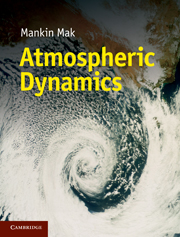Book contents
- Frontmatter
- Contents
- Preface
- 1 Fundamental concepts and physical laws
- 2 Basic approximations and elementary flows
- 3 Vorticity and potential vorticity dynamics
- 4 Friction and boundary layers
- 5 Fundamentals of wave dynamics
- 6 Quasi-geostrophic theory and two-layer model
- 7 Dynamic adjustment
- 8 Instability theories
- 9 Stationary planetary wave dynamics
- 10 Wave-mean flow interaction
- 11 Equilibration dynamics of baroclinic waves
- 12 Nongeostrophic dynamics
- Appendix: Mathematical tools
- References
- Index
- Plate section
1 - Fundamental concepts and physical laws
Published online by Cambridge University Press: 05 June 2012
- Frontmatter
- Contents
- Preface
- 1 Fundamental concepts and physical laws
- 2 Basic approximations and elementary flows
- 3 Vorticity and potential vorticity dynamics
- 4 Friction and boundary layers
- 5 Fundamentals of wave dynamics
- 6 Quasi-geostrophic theory and two-layer model
- 7 Dynamic adjustment
- 8 Instability theories
- 9 Stationary planetary wave dynamics
- 10 Wave-mean flow interaction
- 11 Equilibration dynamics of baroclinic waves
- 12 Nongeostrophic dynamics
- Appendix: Mathematical tools
- References
- Index
- Plate section
Summary
We begin by discussing the fundamental concepts and the laws of physics that underlie the formulation of any dynamical analysis of atmospheric problems. We elaborate on how to conceptualize a fluid medium and how to mathematically quantify the state of a fluid in Section 1.1. We proceed to review a set of physical laws that govern the behavior of all disturbances in a dry atmosphere setting, detailing their physical meaning and mathematical representations in Sections 1.2 through 1.6. The observed distributions of two important mean characteristics of the atmosphere, namely its stratification and baroclinicity, are finally examined in Section 1.7.
Basic notions
Continuum hypothesis
Although the atmosphere may be visualized as a collection of randomly moving gas molecules in constant collision with one another, we conceptualize it as a fluid when we make dynamical atmospheric analyses by invoking a continuum hypothesis. We only seek to quantify the macroscopic properties of the atmosphere. One such property is the wind defined to be the average velocity of the molecules in a very small volume about each location. We call such a loosely defined amount of air molecules an atmospheric fluid parcel. We therefore think of the atmosphere as a fluid medium consisting of innumerable parcels. Furthermore, we assume that each property of the atmosphere varies continuously in time and space, whereby we may evaluate their derivatives with respect to the space variables and time in an analysis.
- Type
- Chapter
- Information
- Atmospheric Dynamics , pp. 1 - 26Publisher: Cambridge University PressPrint publication year: 2011



